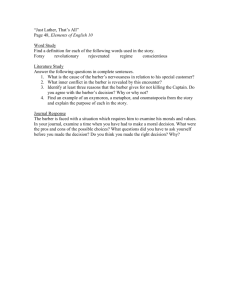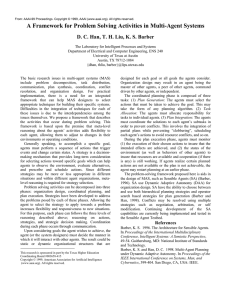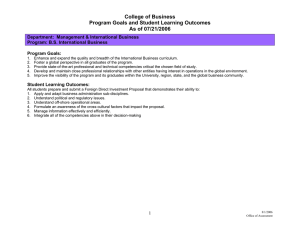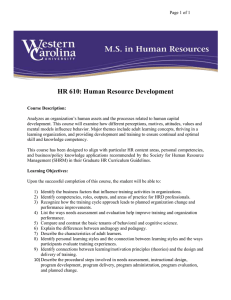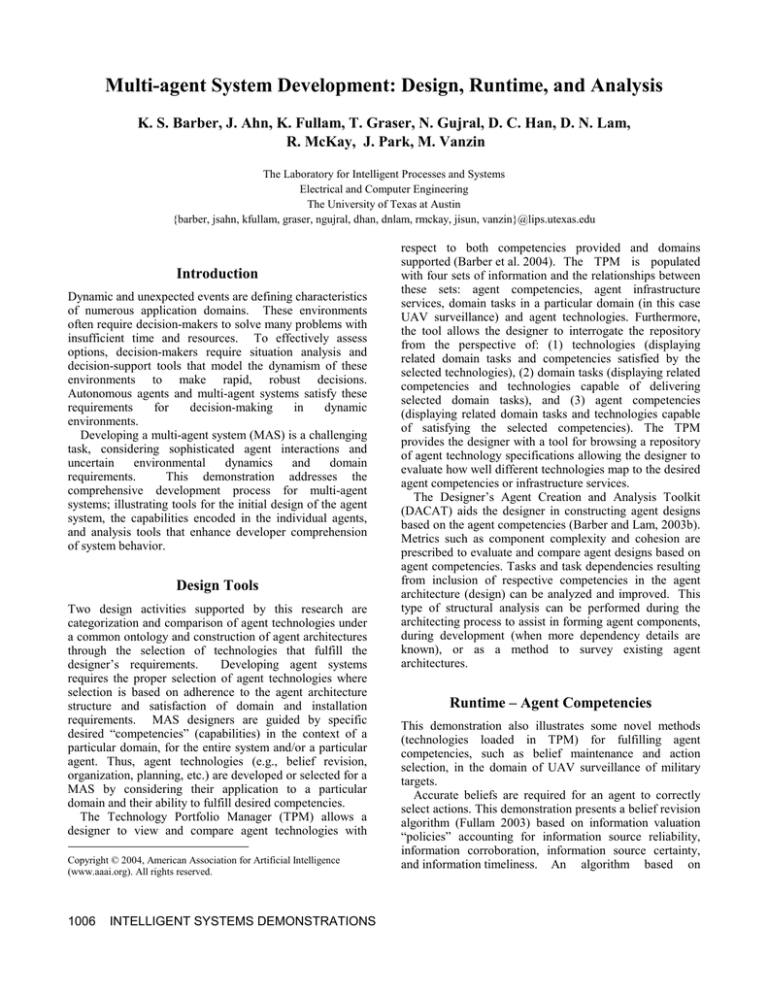
Multi-agent System Development: Design, Runtime, and Analysis
K. S. Barber, J. Ahn, K. Fullam, T. Graser, N. Gujral, D. C. Han, D. N. Lam,
R. McKay, J. Park, M. Vanzin
The Laboratory for Intelligent Processes and Systems
Electrical and Computer Engineering
The University of Texas at Austin
{barber, jsahn, kfullam, graser, ngujral, dhan, dnlam, rmckay, jisun, vanzin}@lips.utexas.edu
Introduction
Dynamic and unexpected events are defining characteristics
of numerous application domains. These environments
often require decision-makers to solve many problems with
insufficient time and resources. To effectively assess
options, decision-makers require situation analysis and
decision-support tools that model the dynamism of these
environments to make rapid, robust decisions.
Autonomous agents and multi-agent systems satisfy these
requirements
for
decision-making
in
dynamic
environments.
Developing a multi-agent system (MAS) is a challenging
task, considering sophisticated agent interactions and
uncertain
environmental
dynamics
and
domain
requirements.
This demonstration addresses the
comprehensive development process for multi-agent
systems; illustrating tools for the initial design of the agent
system, the capabilities encoded in the individual agents,
and analysis tools that enhance developer comprehension
of system behavior.
Design Tools
Two design activities supported by this research are
categorization and comparison of agent technologies under
a common ontology and construction of agent architectures
through the selection of technologies that fulfill the
designer’s requirements.
Developing agent systems
requires the proper selection of agent technologies where
selection is based on adherence to the agent architecture
structure and satisfaction of domain and installation
requirements. MAS designers are guided by specific
desired “competencies” (capabilities) in the context of a
particular domain, for the entire system and/or a particular
agent. Thus, agent technologies (e.g., belief revision,
organization, planning, etc.) are developed or selected for a
MAS by considering their application to a particular
domain and their ability to fulfill desired competencies.
The Technology Portfolio Manager (TPM) allows a
designer to view and compare agent technologies with
Copyright © 2004, American Association for Artificial Intelligence
(www.aaai.org). All rights reserved.
1006
INTELLIGENT SYSTEMS DEMONSTRATIONS
respect to both competencies provided and domains
supported (Barber et al. 2004). The TPM is populated
with four sets of information and the relationships between
these sets: agent competencies, agent infrastructure
services, domain tasks in a particular domain (in this case
UAV surveillance) and agent technologies. Furthermore,
the tool allows the designer to interrogate the repository
from the perspective of: (1) technologies (displaying
related domain tasks and competencies satisfied by the
selected technologies), (2) domain tasks (displaying related
competencies and technologies capable of delivering
selected domain tasks), and (3) agent competencies
(displaying related domain tasks and technologies capable
of satisfying the selected competencies). The TPM
provides the designer with a tool for browsing a repository
of agent technology specifications allowing the designer to
evaluate how well different technologies map to the desired
agent competencies or infrastructure services.
The Designer’s Agent Creation and Analysis Toolkit
(DACAT) aids the designer in constructing agent designs
based on the agent competencies (Barber and Lam, 2003b).
Metrics such as component complexity and cohesion are
prescribed to evaluate and compare agent designs based on
agent competencies. Tasks and task dependencies resulting
from inclusion of respective competencies in the agent
architecture (design) can be analyzed and improved. This
type of structural analysis can be performed during the
architecting process to assist in forming agent components,
during development (when more dependency details are
known), or as a method to survey existing agent
architectures.
Runtime – Agent Competencies
This demonstration also illustrates some novel methods
(technologies loaded in TPM) for fulfilling agent
competencies, such as belief maintenance and action
selection, in the domain of UAV surveillance of military
targets.
Accurate beliefs are required for an agent to correctly
select actions. This demonstration presents a belief revision
algorithm (Fullam 2003) based on information valuation
“policies” accounting for information source reliability,
information corroboration, information source certainty,
and information timeliness. An algorithm based on
policies for information valuation provides justification for
derived beliefs by identifying influential policies as reasons
why more valuable information is given priority over less
valuable information. This research makes a major
contribution toward producing quality beliefs for decisionmaking by examining information quality assessment in
terms of a number of factors, not only information source
reliability. In addition, basing information valuation on
logical policies promotes traceability in algorithm
construction. Justification for derived beliefs is provided, a
useful feature for any domain in which humans are the
ultimate decision-making authority.
In addition to the underlying belief revision algorithm,
the organization of the agents affects which beliefs are
adopted or revised. To maintain autonomy, an agent
should control formation of its beliefs. The degree of an
agent’s belief autonomy is its degree of dependence on
others to build its beliefs, which can be controlled by
selecting the most appropriate agents on which to rely.
Large, open environments make finding the most
appropriate information sources difficult since agents may
only know about a limited number of sources and sources
may enter and leave the system. Finding partners can be
facilitated by decomposing the agents in a system into
small groups so that the scale and openness can be
efficiently managed within the group. The partner-finding
process benefits from trustworthiness information with
respect information quality assurance, increasing the
agents’ goal achievement probability (Barber and Park,
2004).
Agents should behave in a rational manner, meaning an
agent should perform actions that enable it to achieve its
goals. Action selection is complicated by the existence of
multiple goals of different priorities and interaction with
other agents. In order to account for all these factors in the
UAV demonstration, action selection is performed in a
decision-theoretic fashion. Goal priorities are represented
in the expected rewards obtained through goal achievement
while agent coordination is performed through
transformations on the reward and cost structure the agent
uses in its action selection process (Barber and Han, 2003).
Analysis Tools
Software comprehension is the analysis of the
implementation and extraction of a design, which ideally
should be equivalent to the original design. In addition to
extracting a design, software comprehension for MAS
involves understanding the behaviors of the constituent
agents with respect to their individual goals. Knowing the
reasons for agent behaviors in the implementation is
important for the development of MAS because those
behaviors must agree with designed behaviors. The
Tracing Method can be used to validate the implemented
behaviors against the designed behaviors as well as
facilitating agent software comprehension (Barber and
Lam, 2003a).
The Tracer tool aims to automate the developer’s task of
analyzing run-time data and relating it to models of agent
structure and behavior. The method involves logging agent
behavior during execution and associating the log entries
and run-time data with agent concepts in the design models.
As a result, the agent concepts (e.g., beliefs about the
current state of the environment) are instantiated with runtime data. Explanations of run-time agent behavior can be
generated using abductive reasoning on this connection
between the implementation and design models.
Agent software comprehension can be performed as soon
as the initial implementation is done to verify that the
agents are performing basic tasks correctly. During and
after implementation, agent comprehension can be used to
help debug the implemented MAS and to insure that the
agents are behaving as expected and for the right reasons.
Acknowledgements
This research was funded in part by the Defense Advanced
Research Projects Agency and Air Force Research
Laboratory, Air Force Materiel Command, USAF, under
agreement number F30602-00-2-0588. The U.S.
Government is authorized to reproduce and distribute
reprints for Governmental purposes notwithstanding any
copyright annotation thereon. The views and conclusions
herein are those of the authors and should not be
interpreted as necessarily representing the official policies
or endorsements, either expressed on implied, of the
Defense Advanced Research Projects Agency (DARPA),
the Air Force Research Laboratory, or the U.S.
Government.
References
Barber, K. S. and Han, D. C. 2003. Decision-Theoretic Action
Selection for Interacting Planning Agents, Technical Report,
TR2003-UT-LIPS-003, Laboratory for Intelligent Processes and
Systems, The University of Texas at Austin.
Barber, K. S.; Ahn, J; Gujral, N; Lam, D. N.; and Graser, T.
2004. Technology Portfolio Manager, Technical Report,
TR2004-UT-LIPS-007, Laboratory for Intelligent Processes and
Systems, The University of Texas at Austin.
Barber, K. S. and Lam, D. N. 2003a. Enabling Abductive
Reasoning for Agent Software Comprehension. In Proceedings of
the IJCAI-03 Workshop on Agents and Automated Reasoning, 713.
Barber, K. S. and Lam, D. N. 2003b. Specifying and Analyzing
Agent Architectures using the Agent Competency Framework. In
Proceedings of the 15th International Conference in Software
Engineering and Knowledge Engineering, 232-239.
Barber, K. S. and Park, J. 2004. Finding Partners to Form
Information Sharing Networks in Open Multi-Agent Systems. In
Proceedings of the The 17th Florida Artificial Intelligence
Research Symposium. Forthcoming.
Fullam, K. (2003) An Expressive Belief Revision Framework
Based on Information Valuation, Master's Thesis, The University
of Texas at Austin.
INTELLIGENT SYSTEMS DEMONSTRATIONS 1007


